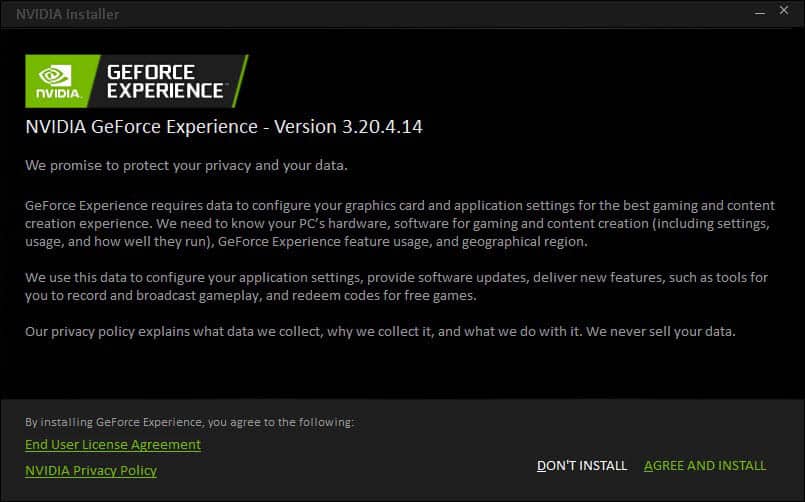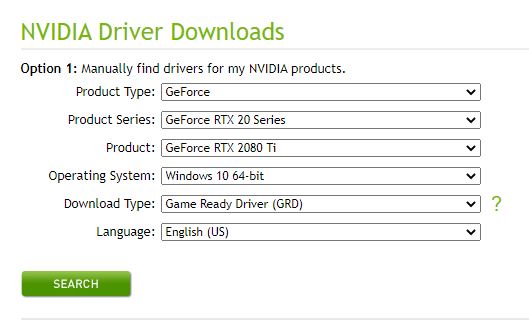Driver installation has always been necessary, but the process has become much simpler thanks to technological advances. Most of the time, Windows 10 (and some earlier versions) will automatically start the installation wizard upon booting the PC with new hardware. However, if you want more control over the process, this guide is for you.
For many years NVIDIA has been consistently dominant over its chief competitor AMD, so it’s no surprise that most users would want an NVIDIA graphics card for their PC. Even if that dynamic might change, NVIDIA is generally the safer choice.
There are apparent benefits to purchasing a new graphics card, but there’s more to it than just opening up the case, plugging in the card, and playing your preferred game.
Like AMD, NVIDIA offers two options for how to install or update your graphics card drivers:
- GeForce Experience – The easier choice of the two. This NVIDIA GPU companion software doesn’t only keep your drivers up to date but also offers a host of other options made specifically for gamers.
- Manually Installing The Drivers – Many modern PC users won’t be familiar with this method, but older gamers certainly will be. You might remember how many times a graphical glitch was solved by searching the official website for drivers after discovering they hadn’t been updated for a while.
Table of ContentsShow
GeForce Experience
Although GeForce Experience is relatively straightforward and easy to use, there are still some prerequisites when installing your drivers using this software.
Before installing your NVIDIA drivers in this manner, it is important to determine whether you are upgrading from an AMD card or an NVIDIA card. This is crucial because occasionally, drivers may leave particular information in the system’s registry, potentially resulting in complications when switching GPU brands.
Step 0 – Uninstalling The Previous Drivers
If you’re switching from an AMD GPU, you will need to delete its drivers. You can do this by going to Control Panel, then clicking Add or Remove Programs. When the new window opens, and the list of programs is displayed, click AMD Software.

In addition to deleting AMD software this way, we recommend downloading a useful app called Display Driver Uninstaller and running it from Safe Mode.
This will guarantee that every final trace of AMD software that might disturb your NVIDIA drivers is thoroughly eliminated from your PC. When employing DDU, you should choose the Purify and Restart option, as the remaining drivers will be automatically eliminated from your PC before it restarts.
At this point, your machine will run at a low resolution, and you will need to install your drivers in this state. The good news is that, at least for now, you have ensured a clean installation.
If you’re upgrading from an NVIDIA card, it won’t be necessary to uninstall your existing drivers.
Step 1 – Preparing For The Installation

This probably goes without saying, but in order to install drivers for your GPU, you first need to have the executable files on your PC. The best way to get the latest NVIDIA software (or specific drivers) is to go to NVIDIA’s website.
In this step, we’re looking at the driver installation via the GeForce Experience program, which you can get here.
Once you have downloaded GeForce Experience, launch it, and you can get started.
Step 2 – Installing The Drivers

When starting the NVIDIA software, you will first be asked to log in to your NVIDIA account.
If you don’t already have an account, you can create one using your social media credentials or inputting your details manually. Either way, after a simple registration section, you will be taken to the home page of Experience.
Here, you will see a list of games you have installed on your PC and will be given the option to optimize their performance by altering visual settings after clicking the ‘Details’ button.
We are currently more interested in the ‘Drivers’ tab in the upper left of the window. After clicking it, you will be given the choice of an express installation or a custom one.
The Express Installation will ask no questions and take no prisoners. It will automatically determine which drivers you need and then install them without requesting permission. During the installation process, your screen will turn black for a couple of seconds, but there’s no need to worry. This is normal while installing display driver updates.
The Custom Installation will give you additional options, but these aren’t necessary for the smooth operation of your graphics card. You will also be offered a ‘clean installation‘ option which restores all settings to their defaults and removes any profiles you have created.

After the process (which is identical to the express installation) is completed, you will have your NVIDIA graphics card drivers set up and can start playing your favorite video games.
Manually Installing The Drivers
The process of removing your previous card’s drivers is identical here. As this was explained in the last section, we won’t repeat the instructions here.
The difference between these two installation methods is that here you will need to manually choose the drivers for your graphics card from the NVIDIA website.

Selecting the appropriate driver is simple enough, but let’s go through it just to be safe.
The ‘Product Type’ you want is likely ‘GeForce’, but if you’re planning to game on a Titan card, you should choose that instead. The ‘Legacy’ option will provide access to display drivers from twenty years ago, which you are unlikely to want for anything other than academic curiosity.
‘Product Line’ will determine which product choices you view in the following stage, so it is important to know the series your GPU belongs to.
Side note: ‘Product’ refers to the specific name of your graphics card. If you bought a GPU with a different manufacturer prefix, for example, MSI or EVGA, you only need to find the model name, and you’re good to go.
‘Operating System’ should be your operating system, provided you can find it in the drop-down menu. If you can’t find it, it’s possible that your PC won’t be able to run the drivers, and you have a different problem on your hands.
The ‘Language’ option simply refers to the language you want to use during the installation.
The important option is the ‘Download Type’. Here you are offered either ‘Game Ready Driver’ or ‘Studio Driver’.
GRD is best if you intend to use your graphics card for the latest games so you can receive the latest driver updates. SD is intended for people who use their graphics cards for more professional purposes, such as 3D modeling or video rendering.
In that case, you won’t need the latest drivers as they are released, and you will only use stable updates.
Once you’ve found your graphics card’s driver, you will be taken to a download page where you can download and install the drivers using the executable file from your file system.
When you run the file, you will be prompted to choose a location for the installation, and the default path will already be selected. After you select your desired path, the installation wizard will install your drivers, and you’re all set to play your video games.
How To Reinstall NVIDIA Drivers
Some people feel that the need for driver re-installation is a relic of a bygone era, but it’s best to cover your bases in case you experience slowdowns or stuttering in your games.
Similar to the installation process, you have two choices for reinstalling the drivers.
When using GeForce Experience, you will find the option in the ‘Drivers’ tab. It isn’t as obvious as we would have liked, but it’s not too hard to find.
In the upper left corner of the tab, you should see a notification that you have the latest drivers installed and the specific version of the driver immediately below it. To the right of the driver’s name, you will see three dots indicating additional options.
When you click on them, you will be given the option to reinstall the drivers.

From here, you will be taken to the same screen you saw when you installed the drivers and were offered the ‘Express Installation’ and ‘Custom Installation’ options. We have already described the process of selecting each one, so you can refer to that section for the following steps.

If you’re looking to reinstall the drivers manually, you will need to go through the same driver uninstallation process that we have already described. Again, it’s best to use Display Driver Uninstaller and fully remove any driver data left on your system.
The process of selecting the appropriate driver for your graphics card is critical. Although we have already explained it, we need to stress that it’s possible that you are experiencing stuttering or similar issues due to having the wrong driver.
It’s vital to know exactly which graphics card you have so you can install the appropriate driver for it.




